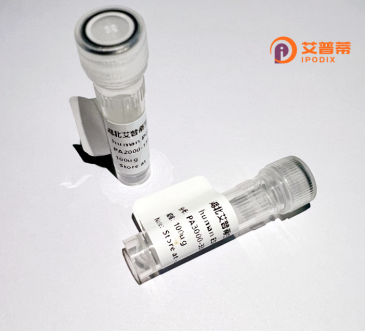
| 纯度 | >90%SDS-PAGE. |
| 种属 | Human |
| 靶点 | C13orf18 |
| Uniprot No | Q9H714 |
| 内毒素 | < 0.01EU/μg |
| 表达宿主 | E.coli |
| 表达区间 | 1-662aa |
| 氨基酸序列 | MVSQSTVRQD SPVEPWEGIS DHSGIIDGSP RLLNTDHPPC QLDIRLMRHK AVWINPQDVQ QQPQDLQSQV PAAGNSGTHF VTDAASPSGP SPSCLGDSLA ETTLSEDTTD SVGSASPHGS SEKSSSFSLS STEVHMVRPG YSHRVSLPTS PGILATSPYP ETDSAFFEPS HLTSAADEGA VQVSRRTISS NSFSPEVFVL PVDVEKENAH FYVADMIISA MEKMKCNILS QQQTESWSKE VSGLLGSDQP DSEMTFDTNI KQESGSSTSS YSGYEGCAVL QVSPVTETRT YHDVKEICKC DVDEFVILEL GDFNDITETC SCSCSSSKSV TYEPDFNSAE LLAKELYRVF QKCWILSVVN SQLAGSLSAA GSIVVNEECV RKDFESSMNV VQEIKFKSRI RGTEDWAPPR FQIIFNIHPP LKRDLVVAAQ NFFCAGCGTP VEPKFVKRLR YCEYLGKYFC DCCHSYAESC IPARILMMWD FKKYYVSNFS KQLLDSIWHQ PIFNLLSIGQ SLYAKAKELD RVKEIQEQLF HIKKLLKTCR FANSALKEFE QVPGHLTDEL HLFSLEDLVR IKKGLLAPLL KDILKASLAH VAGCELCQGK GFICEFCQNT TVIFPFQTAT CRRCSACRAC FHKQCFQSSE CPRCARITAR RKLLESVASA AT |
| 分子量 | 73.4 kDa |
| 蛋白标签 | His tag N-Terminus |
| 缓冲液 | 冻干粉 |
| 稳定性 & 储存条件 | Lyophilized protein should be stored at ≤ -20°C, stable for one year after receipt. Reconstituted protein solution can be stored at 2-8°C for 2-7 days. Aliquots of reconstituted samples are stable at ≤ -20°C for 3 months. |
| 复溶 | Always centrifuge tubes before opening.Do not mix by vortex or pipetting. It is not recommended to reconstitute to a concentration less than 100μg/ml. Dissolve the lyophilized protein in distilled water. Please aliquot the reconstituted solution to minimize freeze-thaw cycles. |
以下是关于重组人RTN4/Nogo(UniProt Q9H714)蛋白的3篇代表性文献摘要:
---
1. **文献名称**: "Identification of the Nogo inhibitor of axon regeneration as a Reticulon protein"
**作者**: GrandPré, T., Nakamura, F., Vartanian, T., & Strittmatter, S.M.
**摘要**: 该研究首次鉴定了Nogo蛋白(RTN4)作为轴突再生抑制剂,并描述了其重组形式在抑制神经元生长中的作用。通过重组RTN4的体外实验,揭示了其通过结合NgR受体抑制神经突触生长的机制。
---
2. **文献名称**: "Structural characterization of the Nogo-66 domain in RTN4"
**作者**: Oertle, T., Huber, C., & Schwab, M.E.
**摘要**: 本文解析了重组表达的人RTN4蛋白中Nogo-66功能域的结构,揭示了其通过发夹样折叠形成的膜结合特性,并探讨了该结构如何参与抑制中枢神经系统损伤后的轴突再生。
---
3. **文献名称**: "Production and functional analysis of recombinant Nogo-A extracellular domain"
**作者**: Dodd, D.A., Niederoest, B., & Bloch, A.
**摘要**: 研究通过哺乳动物细胞系统重组表达了Nogo-A的胞外结构域,验证了其体外活性,并证明其在髓鞘相关轴突生长抑制中的关键作用,为神经再生治疗提供了实验基础。
---
如有特定研究方向需求(如疾病模型或药物开发),可进一步补充针对性文献。
**Background of Recombinant Human Protein Q9H714 (FAM3B/PANDER)**
The recombinant human protein Q9H714. encoded by the *FAM3B* gene, is also known as PANcreatic DERived factor (PANDER). It belongs to the FAM3 (family with sequence similarity 3) family, characterized by a conserved GCG domain with structural homology to cytokines. PANDER is a small (~22 kDa), secreted protein predominantly expressed in pancreatic islets, particularly in β-cells, and plays a role in glucose metabolism and insulin regulation. Structurally, it adopts a 4-α-helical bundle fold, similar to IL-4 or IL-10. with potential glycosylation and dimeric conformations influencing its bioactivity.
Functionally, PANDER is implicated in β-cell apoptosis under hyperglycemic conditions, contributing to diabetes pathogenesis. It interacts with hepatic receptors to modulate gluconeogenesis and insulin sensitivity, though precise mechanisms remain under investigation. Studies highlight its dual role: promoting β-cell death via caspase activation while suppressing glucagon secretion in α-cells. Dysregulation of PANDER is linked to type 2 diabetes, obesity, and metabolic syndrome, making it a potential therapeutic target.
Research tools like recombinant PANDER facilitate explorations into its signaling pathways (e.g., PI3K/Akt, JNK) and its interplay with hormones like insulin and glucagon. Despite progress, its receptor and full physiological impact require further elucidation.
×